Provide each child with fish counters, an ocean image, a dark cloth or paper, and a small pond (plate). Children take turns drawing a card to determine how many fish to help get into the ocean (addition) or how many will be eaten by the shark (subtraction). After drawing a card, children move the fish to their checking plate, then their partner checks to make sure they have the correct number. Children then cover their oceans with the cloth so they cannot see the fish. Both children then move the fish from their checking plate to the ocean (under the cloth) or shark. Children discuss how many fish are in their oceans now, without peeking under the cloth. They then remove the cloth to check. The other child draws a card and play continues.
Primary Objective
- Producing and understanding number combinations of totals to 5 or more.
- Developing an understanding of addition and subtraction problems with numbers up to 5 or more.
How to Use
If most of your children are not yet able to count forward or back from a number other than one without support and demonstrate a knowledge of number combinations to five or more, you should instead preview the Visible Ocean version.
Materials
- Ocean picture (1 for each child)
- Checking plate (“pond”; 1 for each child)
- Small bowl (1 for each child)
- Fish counters (~10 for each child)
- Cloth or piece of paper (1 for each child)
- Shark box (1 per small group)
- Think-Pair-Share cards
- Counting cards (1 set; see Summary of Activity Adaptations for other counting card options)
- 0-10 numeral and dot
- Plus/Minus cards (one set)
- Number Path (one; see Summary of Activity Adaptations for other number path options)
- 0-5, 0-10, or 0-20 path
- Step Icons
Steps of the Activity
The activity steps icons below outline the steps of the activity. Print these icons as cards and share them to help children remember the steps. They’re also a helpful scaffold for children!
Find a sample script for teachers to use here.

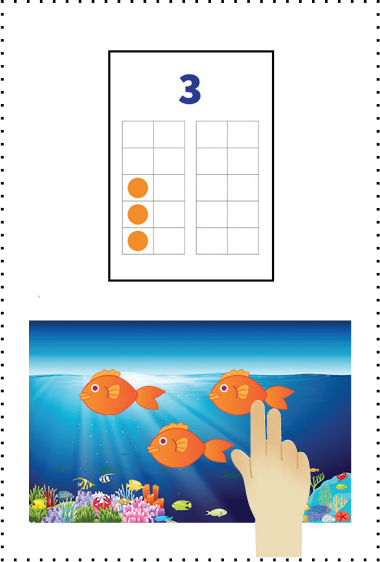
Step 1
Teacher chooses a starting number of fish from the bowl and shows the corresponding Counting Card and places that many fish in their ocean.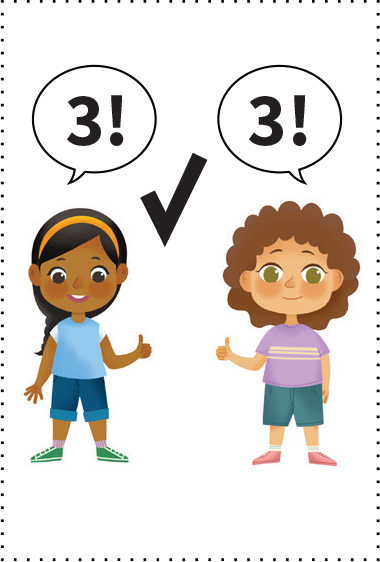
Step 2
Teacher asks child, “Am I right?” Child checks.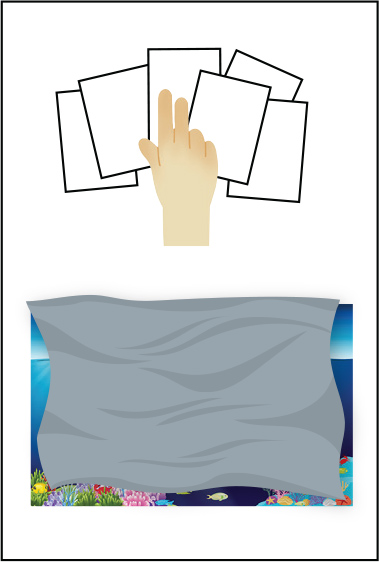
Step 3
Teacher covers the ocean with the cloth and child selects one face-down Plus/Minus card.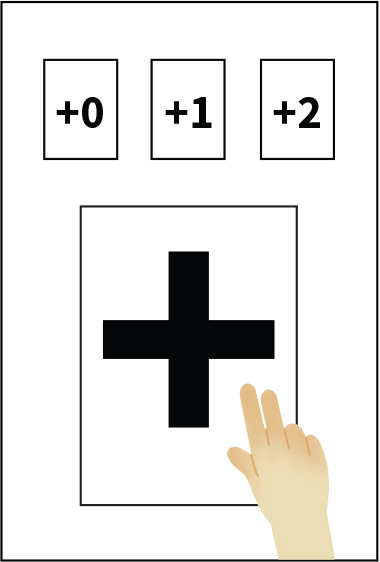
Step 1
Children state how many fish are to be added or subtracted based on the Plus/Minus card selected (e.g., +1).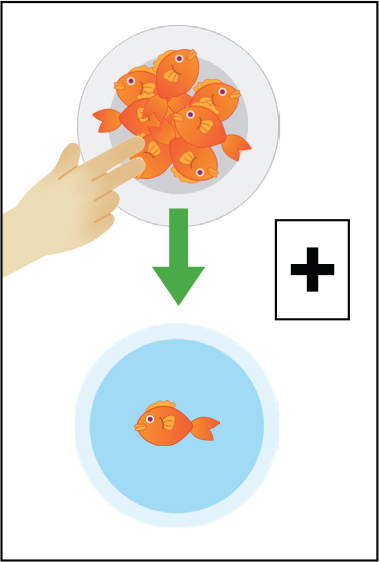
Step 2
Teacher “jumps” that many fish from the bowl and into the checking pond (small plate).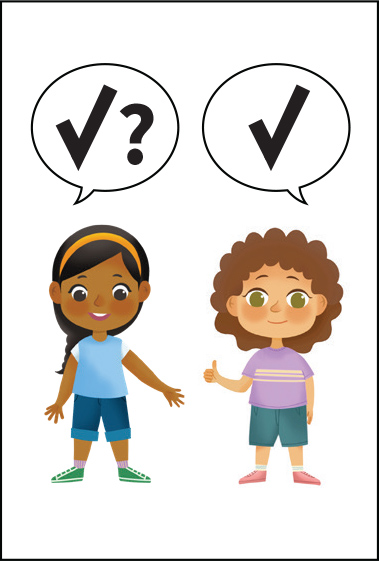
Step 3
Teacher asks child, “Am I right?” Child checks.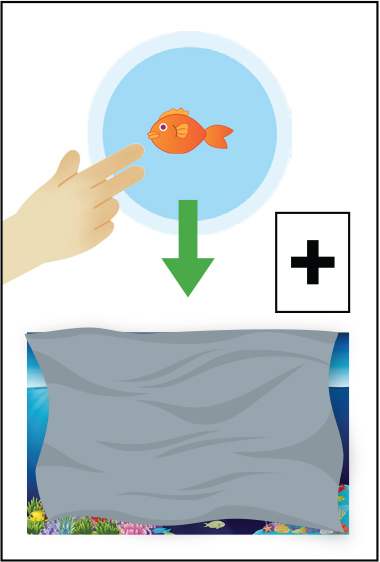
Step 4
Teacher “jumps” their fish from the checking pond into the ocean (under the cloth).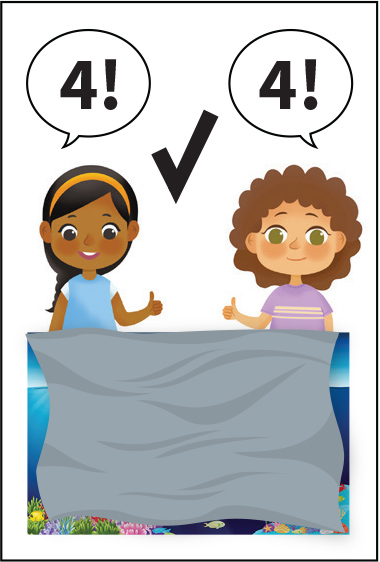
Step 5
Children think-pair-share with a partner about how many fish are in the ocean now and how they know (without looking under the cloth).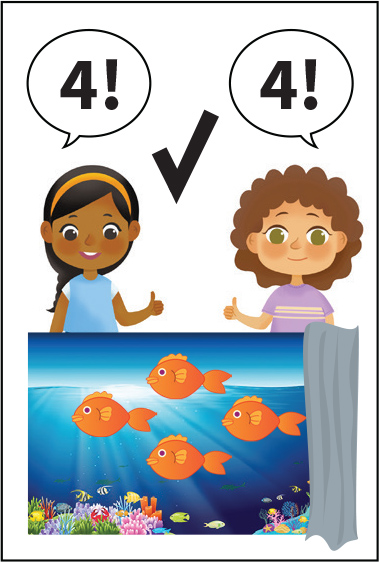
Step 6
Children remove the cloth from the ocean to check how many fish are still in their ocean.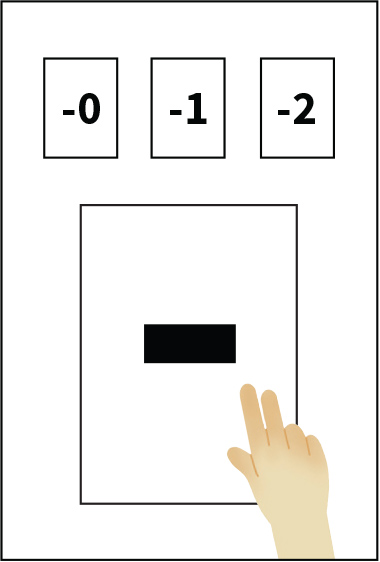
Step 1
Children state how many fish are to be subtracted based on the Plus/Minus card selected (e.g., -1).
Step 2
Teacher “jumps” that many fish from the ocean and into the checking pond, without removing the cloth.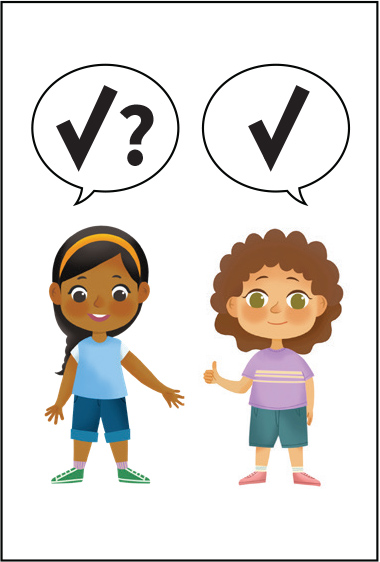
Step 3
Teacher asks child, “Am I right?” Child checks.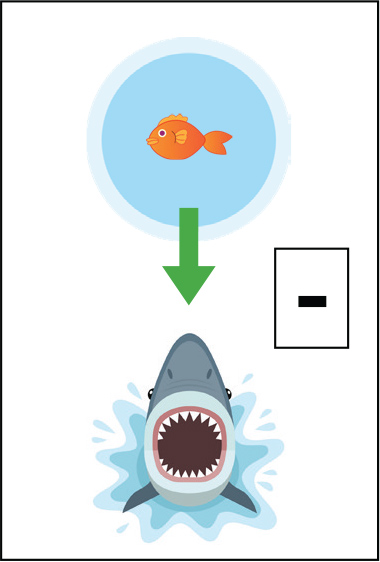
Step 4
Teacher “jumps” their fish from the checking pond into the shark’s mouth.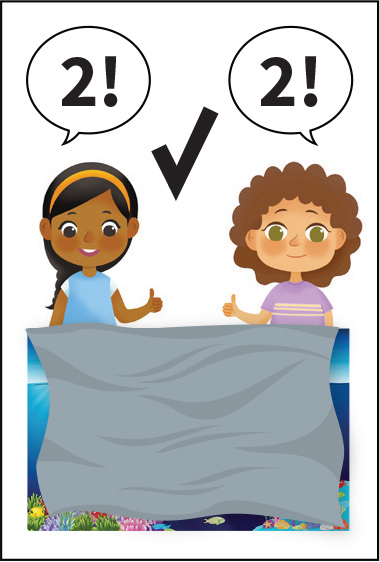
Step 5
Children think-pair-share with a partner about how many fish are in the ocean now and how they know (without looking under the cloth).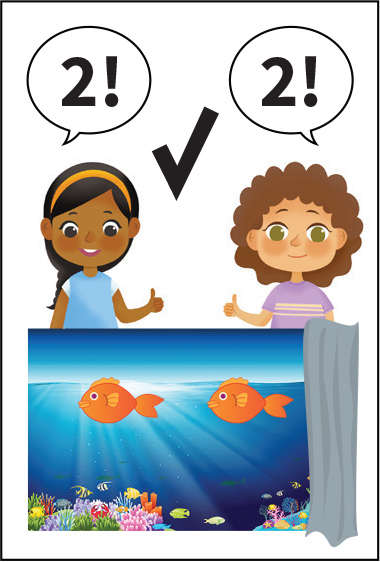
Step 6
Children remove the cloth from the ocean to check how many fish are still in their ocean.Instructions
Instructions for introducing the activity to the Whole Group .
| Introduce the Activity | |
We are going to pretend to be sharks that eat the little fish! Okay, let’s all pretend to be BIG sharks and swim in the water. Here is our shark that we’ll use for this game! |
Have children move their arms to pretend they’re swimming, or something similar. Show children the shark box. |
Now, these fish are so little they can’t swim very far. So, when they want to go in the ocean or leave the ocean, they have to go into the pond first. |
Have the ocean image visible to children. Put the fish into the small bowl; show the fish as you talk about them. The small plate serves as the “pond”; model moving one fish from the bowl to the “pond”. |
| Model the Activity | |
Let’s try it! |
|
First, let’s see how many fish are going to be in our ocean to start. |
Point to the first step icon card. Show a counting card indicating the number of starting fish (3). MAKE IT EASIER
MAKE IT HARDER
|
Three! We’ll put three fish in our ocean. Count with me. 1, 2, 3. 3! |
Count as you put three fish onto the ocean board. MAKE IT EASIER
|
Am I right? |
Point to the second step icon card. Point to each fish in the ocean plate while children count, “1, 2, 3… 3!” |
Oh no! There was a storm and now our oceans are muddy and we can’t see the fish! So, how many fish were in our ocean? |
Point to the third step icon card. Use the cloth to cover the fish on the ocean board. Encourage children to indicate how many fish are in their ocean without removing the cloth (do not add or remove any fish here). |
Now, we pick a card to find out if more fish are going to swim into our ocean or be eaten by the shark! |
Point again to the third step icon card. Pick a Plus/Minus card from the stack. You can decide on an operation (addition or subtraction) and a number ahead of time based on children’s skills. Go to the addition steps or subtraction steps depending on which card was picked. MAKE IT EASIER
MAKE IT HARDER
|
| ADDITION STEPS | |
Plus 1! That means one more fish swims into our ocean. But remember, these fish are so little they can’t swim very far. So it has to swim into the pond first. |
Point to the fourth ADDITION step icon card. Show the +1 Plus/Minus card. MAKE IT EASIER
MAKE IT HARDER
Introduce terms such as sum and plus. |
One fish swam into our pond. |
Point to the sixth ADDITION step icon card. Put one fish on the checking plate (pond). |
Let’s count to make sure we have one. Count with me! Am I right? |
Point to the sixth ADDITION step icon card. Point to the fish on the checking plate while children count, “1… 1!” |
Now our fish is going to jump into our muddy ocean! |
Point to the seventh ADDITION step icon card. Keeping the cloth on the ocean, add the fish from the checking plate under the cloth. |
Now we figure out—How many fish are in our ocean now? Think-Pair-Share with your partner. |
Point to the eighth ADDITION step icon card. Children Think-Pair-Share with a partner to determine how many fish are in the ocean now. Keep the cloth on the ocean and fish. MAKE IT EASIER
Briefly remove the cloth to allow children to look at the number of fish in their oceans, count them as a group, then cover them up again. MAKE IT HARDER
|
We started with three fish, then one more swam into the ocean, so now we have four fish in our ocean! Let’s clear out the mud to check! |
Point to the ninth ADDITION step icon card. Verbalize the starting number and the number added. Remove the cloth to “clear the mud” and verify how many are in the ocean now. MAKE IT EASIER
Model counting (with fish, counters, or fingers), keeping the two parts separate (the starting set and the part added). MAKE IT HARDER
|
Oh no! The storm is back! |
Point to the third step icon card. |
| SUBTRACTION STEPS | |
Now, the shark is hungry! Let’s find out how many fish it’s going to eat… |
Point again to the third step icon card. Select one SUBTRACTION card from the Plus/Minus cards. REMEMBER… if children are not yet ready for subtraction, stick with addition only. |
It gets to eat one fish! Show me your shark mouths. |
Point to the fourth SUBTRACTION step icon card. Flip over the -1 Plus/Minus card. You can decide on the number ahead of time based on children’s counting skills. Have children move their arms to pretend they’re sharks. NOTE: If the number being subtracted is too large for the number of fish left in the ocean, choose another plus/minus card, saying something such, “Oh, no! Our card says the shark is going to eat three fish, but we only have two fish left. We don’t have that many fish in our ocean. Let’s pick another card.” MAKE IT EASIER
MAKE IT HARDER
Introduce terms such as minus and difference. |
Let’s take one fish from the ocean and put it into the pond. Remember, the ocean is muddy so we can’t SEE the fish. |
Point to the fifth SUBTRACTION step icon card. Keeping the cloth on the ocean and the fish covered, remove one fish from the ocean to the checking plate. |
Let’s make sure we have only one. Am I right? |
Point to the sixth SUBTRACTION step icon card. |
Watch! One fish jumps into the shark’s mouth! Count with me. 1…1. The shark is so happy! |
Point to the seventh SUBTRACTION step icon card. Move the fish from the checking plate to the shark’s mouth. Encourage children to count with you. |
Now we figure out—How many fish are in our muddy ocean now? Think-Pair-Share with your partner. |
Point to the eighth SUBTRACTION step icon card. Children Think-Pair-Share with a partner to determine how many fish are in the muddy ocean now. Keep the cloth on the ocean and fish. MAKE IT EASIER
MAKE IT HARDER
|
We had four fish, then the hungry shark ate one. Now, we have three fish in our ocean! Let’s clear out the mud to check! |
Point to the ninth SUBTRACTION step icon card. Verbalize the starting number and the number subtracted. Remove the cloth to “clear the mud” and verify how many are in the ocean now. MAKE IT EASIER
Model counting (with fish, counters, or fingers), keeping the two parts separate (the starting set and the part removed). MAKE IT HARDER
|
Let’s play some more! |
Keep playing, adding and subtracting fish as time allows.
|
Explore The Executive Function And Math Skills In This Activity
- Counting Level
- Adding/Subtracting Levels
What to do next
Are some students ready for more challenge? Try the adaptations provided above for Whole Group. On another day, have the students play in pairs in a Small Group.
If some of your students aren’t yet consistently able to count forward or back from a number other than one without support and do not yet demonstrate a knowledge of number combinations to five or more, they may benefit more from playing Visible Ocean.
Materials
- Ocean picture (1 for each child)
- Checking plate (“pond”; 1 for each child)
- Small bowl (1 for each child)
- Fish counters (~10 for each child)
- Cloth or piece of paper (1 for each child)
- Shark box (1 per small group)
- Think-Pair-Share cards
- Counting cards (1 set; see Summary of Activity Adaptations for other counting card options)
- 0-10 numeral and dot
- Plus/Minus cards (1 set)
- Number Path (one; see Summary of Activity Adaptations for other number path options)
- 0-5, 0-10, or 0-20 path
- Step Icons
Steps of the Activity
For small groups, we suggest four children arranged in pairs of two with a teacher present to provide guidance.
The activity steps icons below outline the steps of the activity. Print these icons as cards and share them to help children remember the steps. They’re also a helpful scaffold for children!
Find a sample script for teachers to use here.

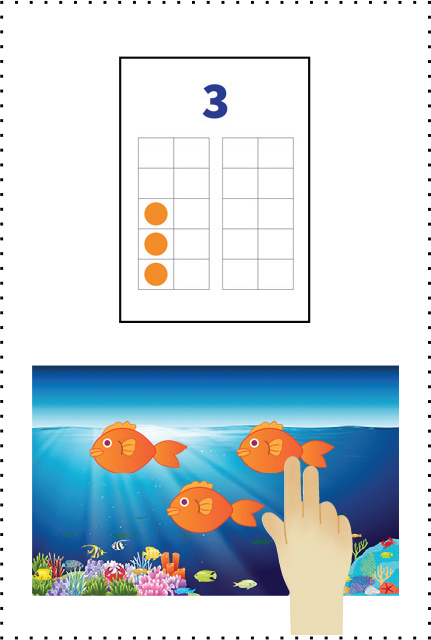
Step 1
Teacher chooses a starting number of fish from the bowl and shows the corresponding Counting Card and places that many fish in their ocean.
Step 2
Teacher asks child, “Am I right?” Child checks.
Step 3
Teacher covers the ocean with the cloth and child selects one face-down Plus/Minus card.
Step 1
Children state how many fish are to be added or subtracted based on the Plus/Minus card selected (e.g., +1).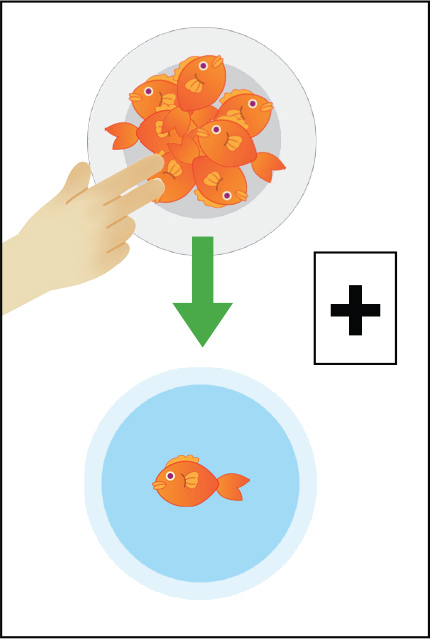
Step 2
Teacher “jumps” that many fish from the bowl and into the checking pond (small plate).
Step 3
Teacher asks child, “Am I right?” Child checks.
Step 4
Teacher “jumps” their fish from the checking pond into the shark’s mouth.
Step 5
Children think-pair-share with a partner about how many fish are in the ocean now and how they know (without looking under the cloth).
Step 6
Children remove the cloth from the ocean to check how many fish are still in their ocean.
Step 1
Children state how many fish are to be added or subtracted based on the Plus/Minus card selected (e.g., +1).
Step 2
Teacher “jumps” that many fish from the ocean and into the checking pond, without removing the cloth.
Step 3
Teacher asks child, “Am I right?” Child checks.
Step 4
Teacher “jumps” their fish from the checking pond into the shark’s mouth.
Step 5
Children think-pair-share with a partner about how many fish are in the ocean now and how they know (without looking under the cloth).
Step 6
Children remove the cloth from the ocean to check how many fish are still in their ocean.Instructions
Instructions for introducing the activity to the Small Group.
| Introduce the Activity | |
We are going to pretend to be sharks that eat the little fish! Okay, let’s all pretend to be BIG sharks and swim in the water. Here is our shark that we’ll use for this game! |
Have children move their arms to pretend they’re swimming, or something similar. Show children the shark box. |
Remember, these fish are so little they can’t swim very far. So, when they want to go in the ocean or leave the ocean, they have to go into the pond first.
|
Provide each child with a bowl with approximately 10 fish, 1 small plate (“pond”), 1 ocean board, and 1 cloth. Have one shark box in the middle of the table for all children to share. |
| Model the Activity | |
Let’s give it a try with your own oceans! How many fish are in your oceans now? |
Allow children to say out loud or echo back, “zero”. Correct children as needed.
|
First, let’s see how many fish are going to be in our ocean to start. |
Point to the first step icon card. Show a counting card indicating the number of starting fish (3). MAKE IT EASIER
MAKE IT HARDER
|
Three! Everyone put three fish into your oceans. |
Have all children place three fish in their oceans. Check to make sure all children have the correct number before continuing. MAKE IT EASIER
|
Now, everyone ask your partner, “Am I right?” Partners, you check to make sure your friend has the right number of fish in their ocean. |
Point to the second step icon card. Encourage children to check each other, correcting as necessary. |
How many fish are in your oceans now? |
Encourage children to respond. |
Oh no! There was a storm and now your oceans are muddy and we can’t see the fish! So, how many fish are in your oceans? |
Point to the third step icon card. Have children use the cloth to cover the fish on their ocean boards. Encourage children to indicate how many fish are in their ocean without removing the cloth (do not add or remove any fish here). |
Remember, you are big sharks and we are going to use these cards to help us find out if more fish are going to swim into the ocean or into the shark’s belly! |
Point to the fourth ADDITION and SUBTRACTION step icon cards as you mention fish going into the ocean or being eaten by the shark, respectively. |
But remember, these fish are so little they can’t swim very far. So they have to swim into the pond first, then our partner helps us check to make sure we have the right number. |
Point to the fifth and sixth ADDITION & SUBTRACTION step icon cards as you describe each step. |
Then, we’ll put the fish into the pond and then into the ocean or the shark. |
Point to the seventh ADDITION & SUBTRACTION step icon card as you describe this step. |
Then, we’ll check to figure out how many fish we have left in our oceans. |
Point to the eighth and ninth ADDITION & SUBTRACTION step icon cards as you describe this step. |
Finally, we’ll pick another card and start again. |
Point to the fourth step icon cards as you describe this step. |
| Time to Play! | |
Okay, everyone has three fish in your oceans. Let’s pick a card to figure out how many fish we’ll put into your oceans or feed to the shark! |
Point to the fourth step icon card. Pick a Plus/Minus card. Go to the addition steps or subtraction steps depending on which card was picked. MAKE IT EASIER
MAKE IT HARDER
|
| ADDITION STEPS | |
Plus 1! That means one more fish is going to swim into your ocean. But remember, these fish are so little they can’t swim very far. So they have to swim into the pond first. Everyone put one fish in your pond. |
Point to the fifth ADDITION step icon card. Show the +1 Plus/Minus card. MAKE IT EASIER
MAKE IT HARDER
Or introduce terms such as sum and plus. |
Now, everyone ask your partner, “Am I right?” Partners, you check to make sure your friend has the right number of fish in their pond. |
Point to the sixth ADDITION step icon card. Encourage children to check each other, correcting as necessary. |
Now your fish are going to jump into your oceans! But, remember, the water is muddy and we can’t see them, so we have to put them under the cloth. |
Point to the seventh ADDITION step icon card. Have children move the fish from their plates to their oceans, under the cloth. |
How many fish are in your ocean now? How do you know? |
Point to the eighth ADDITION step icon card. Children Think-Pair-Share with a partner to determine how many fish are in their oceans now. MAKE IT EASIER
Briefly remove the cloth to allow children to look at the number of fish in their oceans, count them as a group, then cover them up again. MAKE IT HARDER
|
You started with three fish, then one more swam into your ocean, so now you have four fish in your oceans! Let’s clear out the mud to check! |
Point to the ninth ADDITION step icon card. Verbalize the starting number and the number added. Children remove the cloth from their ocean to verify how many are in their ocean now. MAKE IT EASIER
Model counting (with fish, counters, or fingers), keeping the two parts separate (the starting set and the part added). MAKE IT HARDER
|
Oh no! The storm is back! |
Point to the third step icon card. Place the cloth over the remaining fish on the ocean board. |
| SUBTRACTION STEPS | |
The big shark is so happy to have four small fish. They’re so hungry! Let’s find out how many fish it’s going to eat… |
Point to the fourth step icon card. Select one card from the Plus/Minus cards. REMEMBER… if children are not yet ready for subtraction, stick with addition only. |
Minus two! That means we take away two fish from the ocean to feed to the shark! |
Point to the fifth SUBTRACTION step icon card. Flip over the -2 Plus/Minus card. NOTE: If the number being subtracted is too large for the number of fish left in the ocean, choose another plus/minus card, saying something such, “Oh, no! Our card says the shark is going to eat three fish, but we only have two fish left. We don’t have that many fish in our ocean. Let’s pick another card.” MAKE IT EASIER
MAKE IT HARDER
Or introduce terms such as minus and difference. |
Let’s take two fish from your oceans and put it into your ponds. Remember, the ocean is muddy so we can’t SEE the fish. |
Point again to the fifth SUBTRACTION step icon card. Keeping the cloth on the ocean and the fish covered, children remove two fish from their ocean to the checking plate.
|
Let’s make sure everyone has two fish. Ask your partner, “Am I right?” |
Point to the sixth SUBTRACTION step icon card. Encourage children to check each other, correcting as necessary. |
Now, everyone feed the shark two fish from your ponds! |
Point to the seventh SUBTRACTION step icon card. Have children move the fish from their checking plates to the shark’s mouth. |
How many fish are in your ocean now? How do you know? |
Point to the eighth SUBTRACTION step icon card. Children Think-Pair-Share with a partner to determine how many fish are in the ocean now. MAKE IT EASIER
MAKE IT HARDER
|
You had four fish, then the hungry shark ate two. Now, you each have two fish in our ocean! Let’s clear out the mud to check! |
Point to the ninth SUBTRACTION step icon card. Verbalize the starting number and the number subtracted. Remove the cloth to “clear the mud” and verify how many are in the ocean now. MAKE IT EASIER
Model counting (with fish, counters, or fingers), keeping the two parts separate (the starting set and the part removed). MAKE IT HARDER
|
Let’s play some more! |
Keep playing, adding and subtracting fish as time allows. |
Explore The Executive Function And Math Skills In This Activity
- Counting Level
- Adding/Subtracting Levels
What to do next
Did some students need more support or more challenge? Don’t forget to try out some of the adaptations provided above for Small Group. Continue working in small groups with teacher support until students can comfortably play with minimal teacher guidance. Then have students practice the activity independently in centers.
Did some of your students play Visible Ocean in Small Group? If so, then they should also play that version during Center Time. Don’t forget, children should play Hidden Ocean in Small Group before playing in Center Time!
Materials
- Ocean picture (1 for each child)
- Checking plate (“pond”; 1 for each child)
- Small bowl (1 for each child)
- Fish counters (~10 for each child)
- Cloth or piece of paper (1 for each child)
- Shark box (1 per small group)
- Counting cards (one set; see Summary of Activity Adaptations for other counting card options)
- 0-10 numeral and dot
- Plus/Minus cards (1 set)
- Number Path (one; see Summary of Activity Adaptations for other number path options)
- 0-5, 0-10, or 0-20 path
- Step icons
Steps of the Activity
For small groups, we suggest four children arranged in pairs of two with a teacher present to provide guidance.
The activity steps icons below outline the steps of the activity. Print these icons as cards and share them to help children remember the steps. They’re also a helpful scaffold for children!
Find a sample script for teachers to use here.


Step 1
Children choose a counting card that determines the starting number of fish and all children place that many fish in their oceans.
Step 2
Children ask their partners, “Am I right?” Children check one another.
Step 3
Children cover their oceans with the cloth and select one face-down Plus/Minus card.
Step 1
Children state how many fish are to be added or subtracted based on the Plus/Minus card selected (e.g., +1).
Step 2
Children “jump” that many fish from their bowl and into their checking pond (small plate).
Step 3
Children ask their partners, “Am I right?” Children check one another.
Step 4
Children “jump” their fish from their checking pond into their ocean (under the cloth).
Step 5
Children state/discuss how many fish are in the ocean now and how they know (without looking under the cloth).
Step 6
Children remove the cloth from their ocean to check how many fish are still in their ocean.
Step 1
Children state how many fish are to be added or subtracted based on the Plus/Minus card selected (e.g., +1).
Step 2
Children “jump” that many fish from their ocean and into the checking pond, without removing the cloth.
Step 3
Children ask their partners, “Am I right?” Children check one another.
Step 4
Children “jump” their fish from their checking pond into the shark’s mouth.
Step 5
Children state/discuss how many fish are in the ocean now and how they know (without looking under the cloth).
Step 6
Children remove the cloth from their ocean to check how many fish are still in their ocean.Instructions
Instructions for introducing the activity to the Center .
| Introduce the Activity | |
Today, the Big Fish Story game we’ve been playing together will be at [name] Center! |
Tell students that the activity will be in Centers to play on their own. We recommend playing the activity in Small Groups at least once before introducing it in Centers. MAKE IT EASIER
Include only +/- 1 cards so children only add or subtract one fish at a time
MAKE IT HARDER
Include both addition and subtraction cards. Include only +/- cards with larger numbers (e.g., +/- 2 or +/- 3).
|
You will have picture cards to help you remember how to play. |
Display the activity step Iions. |
| Time to Play! | |
Let’s remind ourselves how to play the game! |
Review the steps of the activity while referencing the Step Icons. When reviewing the Step Icons, tell children that they will be choosing the counting card in Step #3 instead of the teacher (as it was done in whole group and small group previously). MAKE IT EASIER
MAKE IT HARDER
|
Explore The Executive Function And Math Skills In This Activity
- Counting Level
- Adding/Subtracting Levels
What to do next
Keep playing this activity in Centers throughout the year. Students who played the Visible Ocean version may switch to the Hidden Ocean version once they’ve been introduced to it in Small Group and and count forward or back from a number other than one without support and demonstrate a knowledge of number combinations to five or more.
Do some students need more support or more challenge? Try the adaptations provided above for Centers